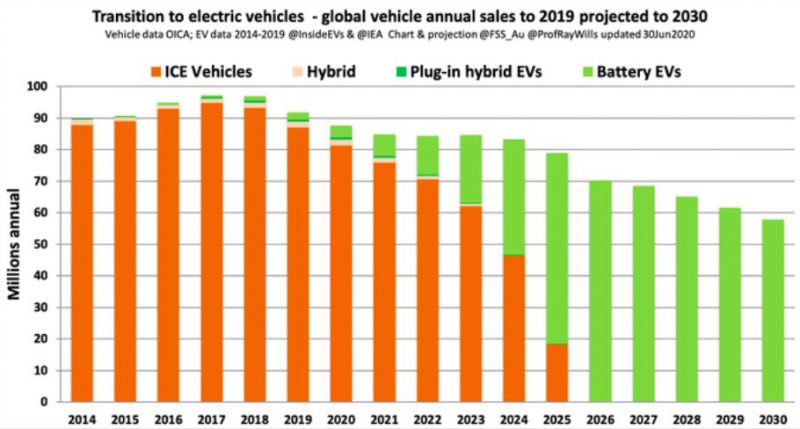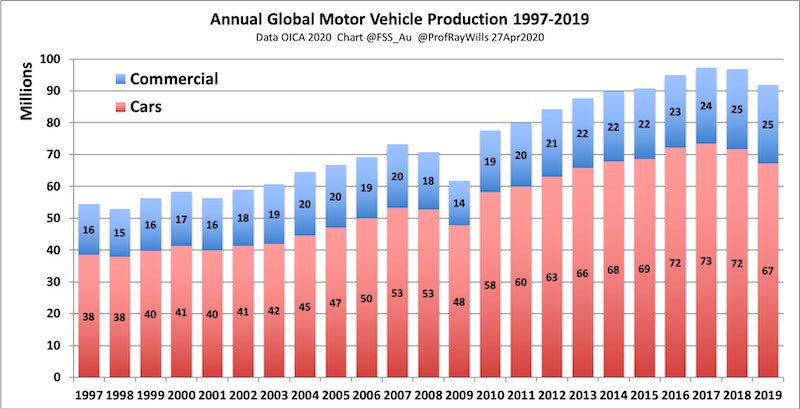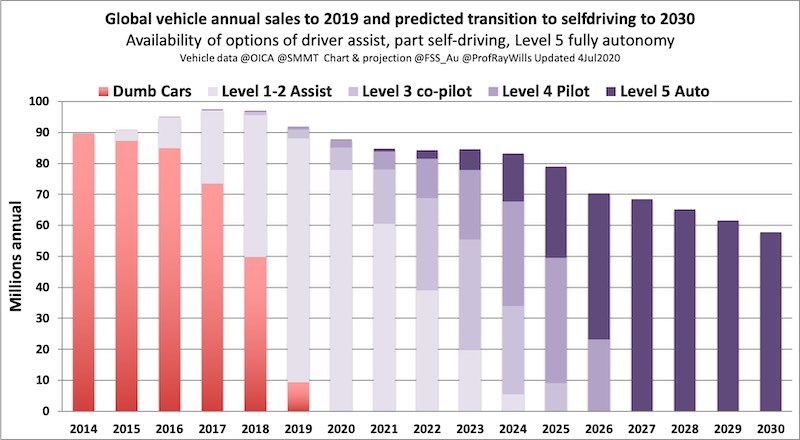The Osborne Effect: Why new car sales will be all electric in six years
On Monday, we wrote about the changes in investor thinking that had pushed the value of Tesla to the point where it has already become the most valuable car company in the world, even though it had barely one thirtieth of its predecessor, Toyota’s, new car sales in 2019.
The focus is very much on the future, and what is likely to happen when the “ticket price” of electric cars falls closer to that of their petrol and diesel equivalents, spurred on new emission standards, technology progress and customer preference.
In that story we included this remarkable graph, courtesy of Professor Ray Wills from Future Smart Strategies (and a director of Horizon Power and an adjunct professor at UWA).
See It’s taken Tesla just 10 years to end Ice Age for Big Auto and Big Oil
It sparked a lot of interest, so we decided to find out more. Is this just a wild prediction? And how does Wills back up his forecast?
This is what Wills told us.
Sales of internal combustion engine cars have been falling consistently and every month since the end of 2017. That is, car sales appear to have peaked in 2017.
In, 2018 new car sales globally were lower than 2017, and in 2019 it was lower than 2018.
(June 2020 is the first rise in that whole time, off the back of COVID19 lows in April and May.
In the mix, hybrid sales have improved – but not to such an extent that would suggest that a breakout and swap from ICE (internal combustion engine) to hybrid is in the offing.
A laggard response by Toyota to electrification and a push by Toyota for hybrid sales as an alternative to battery electric vehicles simply reflects their dominance in that sector.
Meanwhile, EV sales are still growing at a rapid rate – despite Covid-19 – and will overtake hybrid sales this year.
And those customers looking for electric vehicles are simply not looking for hybrid solutions, which explains why plug-in hybrids haven’t been more popular.
While sales of some models of electric car sales have slowed a little during Covid-19, lead models like Tesla have not stalled, and overall growth of comparative market share of electric vehicles is still positive.
The continuing erosion of ICE sales through 2020 as the Osborne Effect continues to impact on overall car sales will convince car makers to release EV models faster.
(The Osborne effect is a social phenomenon of customers canceling or deferring orders for the current soon-to-be-obsolete product as an unexpected drawback of a company’s announcing a future product prematurely.
Remember it!).
And when they do, there will be greater tension on pricing.
All major car makers have at least one model of electric vehicle, and have factories able to be retooled to produce electric cars rather than ICE cars.
(See Volkswagen factory produces last ever combustion engine car, shifts to EVs only).
Once traditional manufacturers get on with it and retool, the arrival of greater volumes of more affordable EVs will carry the day.
And these new electric cars don’t actually compete with other EVs – and the don’t threaten Tesla (there is no “Tesla killer”).
More EVs simply replace ICE.
And it seems a short supply means new EVs actually leaves ICE cars unsold, not other EVs.
We at Future Smart Strategies are still anticipating the early arrival of autonomy, particularly as many vehicles now come with the hardware installed, and higher levels of autonomy in many cases will simply require a software upgrade.
And, finally, to autonomy.
It forms the largest part of the coming disruption to motor vehicles.
Autonomy will change market in a way most find unimaginable – an inevitable erosion of vehicle fleet: adoption of autonomy raises vehicle utilisation rates and, despite a decline of fleet size by more than half, we will see more road miles per vehicle and more road miles overall.
Autonomy and electrification are unrelated tech, but will bring mutual boost in the replacement of the existing fleet – and a faster turnover of fleet brings safety up for everyone on the road.
Look how quickly level 1 and 2 assist spelled the end of “dumb cars” – it took just four years (graph above).
We are seeing most new electric vehicles are safer across multiple metrics than new ICE cars. After 100 years to make cars as safe as possible, cars have so far only been made little safer.
But EVs also bring crash-safety revolution via the latest driver assist being included in the new vehicles, systems that can then be upgraded to higher levels of autonomy via software updates.
This revolution will save lives – the majority of humans are bad drivers, and invariably will make poor choices on the road, while autonomous vehicles will make safer choices for us.
https://thedriven.io/2020/07/07/the...-car-sales-will-be-all-electric-in-six-years/
Tesla Model 3 boosts UK electric car market in June as overall market slumps
The Tesla Model 3 makes its mark in the UK, where EV sales surge in June as the overall new car market slumps again.
https://thedriven.io/category/ev-news/
South Australians keen to switch to electric vehicles, new survey finds
A new survey conducted by the Royal Automobile Association of South Australia (RAA) has found that more than 40% of the State’s motorists are considering buying an electric vehicle when purchasing their next car.
https://thedriven.io/2020/07/07/sou...switch-to-electric-vehicles-new-survey-finds/
Oslo city hits new milestone – most electric vehicles per capita
Oslo’s environment agency has just announced a major milestone – the city now has 50,000 pure electric vehicles, and together with Bergen, sits right at the top of the world in terms of the number of electric vehicles per capita.
https://thedriven.io/2020/07/07/oslo-city-hits-new-milestone-most-electric-vehicles-per-capita/
Porsche Continues To Convert Leipzig Factory To Build EVs
It’s preparing to start building the third generation Macan, which will be all-electric.
Porsche’s factory in Leipzig, Germany, currently builds the Panamera and Macan models, both of which have ICE power plants. But that’s set to change in the near future as the manufacturer has confirmed that the next-gen Macan will be an all-electric model.
The production facility, which employs over 4,000 workers, will receive over €600-million in investments in the near future, part of which will go towards erecting a new body shop; since it was opened, in 2000, the facility has seen nearly €1.3-billion in total investments.
The new body shop is specifically being built to accommodate production of the all-new battery-powered Macan.
Gerd Rupp, Chairman of the Executive Board at Porsche Leipzig, said
‘ Over the past few weeks, we have reached some important milestones on our way to becoming an electromobility site.
The period of time between now and the start of production of the next Macan generation is certainly going to be a challenge.
However, it is also an opportunity to future-proof the plant and to prove ourselves as a team. ‘
Aside from the creation of the new 75,500 square meter (812,675 square foot) body shop, Porsche also announced it will be modifying the existing production line in order for it to accommodate ICE powertrains, as well as hybrids (which have been produced at the plant for nearly 10 years) and full electrics.
The automaker also added a fast charging station outside the facility too.
This is called ‘ Porsche Turbo Charging ‘ and it has a total capacity of 7 megawatts.
Porsche says this makes the site Europe’s most powerful charging park.
Regarding the all new Macan that will be built in Leipzig, Porsche has not really revealed much aside from the fact that it will be an EV.
We do know it’s expected to debut in 2022, as well as the fact that Porsche may still offer plug-in hybrid and conventional ICE variants of the model alongside the EV.
With the EV powertrain, though, Porsche will be able to push power levels to new heights for the top of the range Macan Turbo and Macan Turbo S variants.
Some reports are even suggesting that the latter may have around 700 horsepower, so we’re really excited to see that come to fruition.
https://insideevs.com/news/432544/porsche-leipzig-factory-investment-macan-electric/
View attachment 2284164
It's "Happening" right before our Very Eyes

It Won't Happen Overnight, but it Will / Is Happening as we speak
We are witnessing History being made atm, a Revolutionary Change in the making
What's that you speak of Frank ?
A paradigm shift is a major change in the concepts and practices of how something works or is accomplished. ... For example, the assembly line created a substantial paradigm shift, not only in the auto industry but in all other areas of manufacturing as well.
On December 1, 1913, Henry Ford installs the first moving assembly line for the mass production of an entire automobile. His innovation reduced the time it took to build a car from more than 12 hours to two hours and 30 minutes.



*To Remind
Future of Mobility
The only thing sure about electric cars is they will eclipse the internal combustion engine—one day. ... Optimists such as Bloomberg New Energy Finance (BNEF) in its 2019 Electric Vehicle Outlook report see the total EV stock soaring to 548 million by 2040, or about 32% of the world's passenger vehicles.
Driving into 2025: The Future of Electric Vehicles
The car industry is undergoing a radical transformation, with most carmakers agreeing the next 10 years will bring more change than the two previous decades.
The next target date cited by automakers as a tipping point is 2025, when everything from materials and fuel to cost and the companies that build cars are set to look dramatically different.
In this report, the J.P. Morgan Research team explores the rise of the electric vehicle and what the industry will look like by 2025.
Shifting Gears to Electric Vehicles
Automakers are preparing to phase out cars powered solely by internal combustion engines (ICEs) as governments look to tackle fuel emissions.
The growth in electric vehicles (EVs) and hybrid electric vehicles (HEVs) is climbing and by 2025, EVs and HEVs will account for an estimated 30% of all vehicle sales.
Comparatively, in 2016 just under 1 million vehicles or 1% of global auto sales came from plug-in electric vehicles (PEVs).
By 2025, J.P. Morgan estimates this will rise close to 8.4 million vehicles or a 7.7% market share. While this jump is significant, it doesn’t compare to the kind of growth expected in HEVs - cars that combine a fuel engine with electric elements.
This sector is forecast to swell from just 3% of global market share to more than 25 million vehicles or 23% of global sales over the same period.
This leaves pure-ICE vehicles with around 70% of the market share in 2025, with this falling to around 40% by 2030, predominantly in emerging markets.

For both North America and Europe, hybrids and BEVs are set to lead over the next decade as plug-in hybrids are not proving too popular in either region.
In Europe, plug-in electric vehicles (BEVs and PHEVs) will rise from roughly a 2% share of total new sales in 2017 to around 9% by 2025, nearly eclipsing 1.5 million vehicles by the middle of the next decade.
A dramatic move away from ICE-only vehicles is expected and by 2025 only plug-in electric vehicles and HEVs will likely be sold.
Over that time period, J.P. Morgan forecasts sales of plug-in electric vehicles in Japan and Korea will reach 384,000 vehicles, representing a market share of 6%, while HEVs will approach 1.8 million vehicles or 27% of total sales.
Meanwhile in the U.S., tougher fuel economy regulation will likely push automakers to expand their EV offerings, but not with the same degree of urgency as in Europe, where there are looming carbon dioxide emissions targets and fines.
Nevertheless, overall EV sales – including BEV, PHEV and hybrids – are estimated to account for over 38% of total sales in 2025.
www.jpmorgan.com/global/research/electric-vehicles
With AVZ sitting in "The Box Seat" atm imo
in the box seat
In the most desirable, superior, advantageous position available.


Food for thought
Frank
- Forums
- ASX - By Stock
- Understanding lithium demand
The Osborne Effect: Why new car sales will be all electric in...
-
- There are more pages in this discussion • 504 more messages in this thread...
You’re viewing a single post only. To view the entire thread just sign in or Join Now (FREE)














